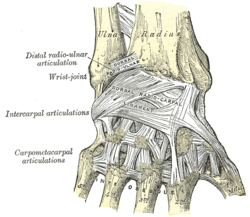Saddle joint
Appearance
This article needs additional citations for verification. (September 2015) |
| Saddle joint | |
|---|---|
 1: Ball and socket joint; 2: Condyloid joint (Ellipsoid); 3: Saddle joint; 4 Hinge joint; 5: Pivot joint; | |
 Ligaments of wrist. Posterior view. | |
| Details | |
| Identifiers | |
| Latin | articulatio sellaris |
| TA98 | A03.0.00.048 |
| TA2 | 1560 |
| FMA | 75298 |
| Anatomical terminology | |
In a saddle joint (sellar joint, articulation by reciprocal reception) the opposing surfaces are reciprocally concave-convex.
Movements
The movements are as same as in the condyloid joint; that is to say, flexion, extension, adduction, abduction, and circumduction are allowed; but no axial rotation. Saddle joints are said to be biaxial, allowing movement in the sagittal and frontal planes.
Examples
The best examples of saddle joints are the metacarpal 1 (thumb) and the trapezium of the wrist.
References
![]() This article incorporates text in the public domain from page 286 of the 20th edition of Gray's Anatomy (1918)
This article incorporates text in the public domain from page 286 of the 20th edition of Gray's Anatomy (1918)
External links
Wikimedia Commons has media related to Saddle joints.
